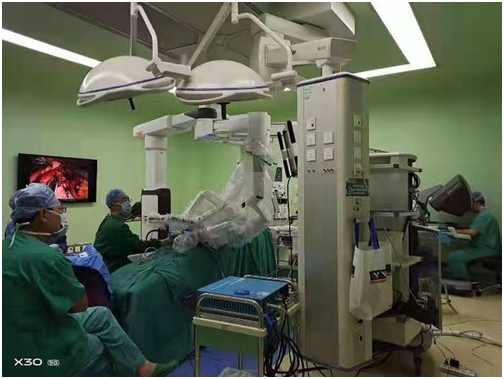On August 2, the Hepatobiliary Surgery Team of the Second Hospital of Shandong University successfully completed the firstradical resection of pancreatic body and tail tumor using the Da Vinci Surgical System in the history of the Hospital. Jin Bin, the deputy dean and chief physician, performed the surgery. The 2h surgery was successful. With just 15ml of bleeding volume, the patient recovered well. The procedure was minimally invasive and saw rapid recovery of the patient.

The patient was a 51-year-old female who came to the Second Hospital of Shandong University due to recurrent abdominal pain and weight loss. She was diagnosed as pancreatic body and tail tumor after admission, and each episode was accompanied by intense abdominal pain. The patient and her family were eager to receive effective treatment.
Given the huge advantage of Da Vinci Surgical System in pancreas procedures, Jin Bin decided to perform pancreatic body and tail tumor radical resection for the patient. During the operation, the pancreatic body and tail tumor and spleen adjacent to the tumor had to be resected along with the dissection of the peripheral lymph nodes. The procedure is extremely demandin on the skills of the operator and the operation skills on the Da Vinci Surgical System.

At 19:00 of August 2, Jin Bin led Li Xiaoming and Yu Chaoqun from the Hepatobiliary Surgery Team, with the support of the Second Department of Anesthesiology and the Second Operation Department, started the surgery and finally successfully completed the resection of pancreatic body and tail tumor and the spleen and the dissection of the peripheral lymph nodes. During the procedure, obvious inflammatory edema was seen around the tumor with severe adhesion. Thanks to good team work, the procedure took less than 2 hours, with about 15ml of intraoperative bleeding volume. The patient returned to the ward safely.
Given the complex anatomy of the pancreas and its proximity to important large blood vessels, the 3D vision of the Da Vinci surgical system (DVSS) enables the surgeons to get the same vision as that of an open surgery, with 10-15 times magnified field of vision which creates the environment for a microsurgery, and its Endo-wrist with 7 DOF ensures the unerring accurate completion of separation, anatomy, suture, and anastomosis, enabling flexible and accurate operation in all angles, and facilitating detailed operations that cannot be handled by human hands in a narrow space. It causes fewer traumas, less bleeding and fewer complications, and allows fast recovery. Therefore, DVSS can play a huge role in performing pancreatic surgeries that are well-known for their complexity. The safety of the operation combing the skilled operation of the surgeons can be significantly achieved.
At present, the Second Hospital of Shandong University is actively promoting comprehensive treatment concepts and new technologies for pancreatic cancer, and regularly performing various difficult and complicated laparoscopic surgeries including laparoscopic hepatectomy, laparoscopic radical resection for hilar cholangiocarcinoma, laparoscopic pancreaticoduodenectomy, pancreatic body and tail radical resection. The Hospital is making continuous efforts to promote comprehensive treatment of pancreatic cancer, and the individualized, standardized and comprehensive diagnosis and treatment at the Department of Hepatobiliary Surgery of the Second Hospital of Shandong University.
{Author: Li Xiaoming Source: Department of Hepatobiliary Surgery
Edited by: Publicity Department/News Center}

